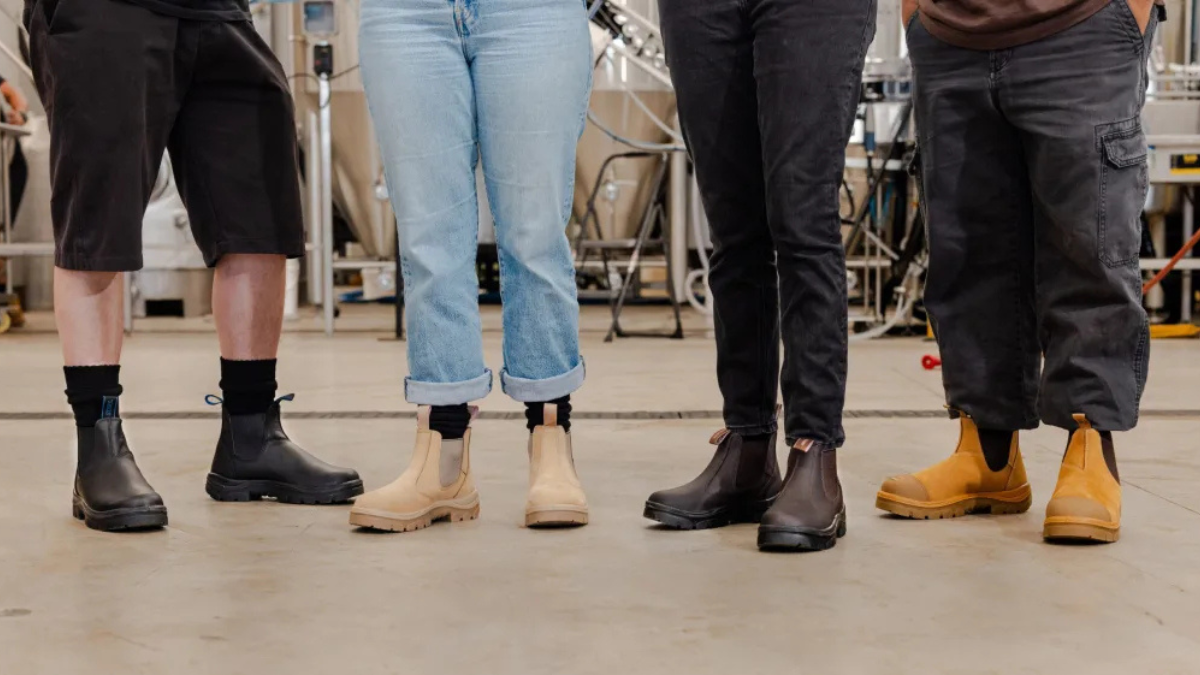
A good pair of boots can make all the difference when you’re working outdoors. If you’re out on the ranch, the jobsite, or in the woods, you need boots that can take a beating.
That’s why picking the right men’s work boots matters.
In this guide, we’ll walk you through what to look for, so you end up with boots that work as hard as you do.

1. Think of where you’ll wear them
Your work environment determines the level of protection your boots should offer.
For example, a ranch hand trudging through mud doesn’t need the same boots as a welder on smooth concrete floors. Terrain, temperature, and daily tasks all matter.
If you’re outdoors in wet or uneven ground, look for waterproof leather, taller shafts, and heavy lug soles. For worksites like warehouses or shops, you might prefer lighter, slip-resistant work boots for men.
2. Pick the right height
Boot height isn’t just about style. It affects how your feet and ankles feel after a long day.
If you’re walking uneven ground, climbing, or carrying heavy loads, go for a taller boot. It gives more ankle support and helps keep out rocks, brush, and debris. Ranchers and linemen often stick with 8" or higher shafts for this reason.
If you’re mostly on flat ground or in and out of vehicles all day, a shorter shaft might be more comfortable. It’s easier to move in and keeps things lighter. For many, a 6" work boot hits the sweet spot.

Caption: Different boot heights, featuring (L-R) Steel Blue Men's Argyle 6" Steel Toe Work Boot, Steel Blue Men's Portland 8" Soft Toe Work Boot, and Steel Blue Men's Blue Heeler Steel Toe Met Boot.
3. Look for strong, durable materials
Work boots take a beating, so they need to be made from materials that hold up.
For example, Kenetrek’s Lineman Extreme 1000 ST is built with thick leather uppers. It is also reinforced with double and triple stitching in high-stress areas.
Generally, full-grain leather is your best bet for any type of heavy-duty work. It’s thick, tough, and resists wear over time. It also breaks in to fit your foot better the more you wear it. Avoid thin or shiny leather. It won’t last on real job sites.
Depending on your work, you might also need toe protection. Steel toe, composite toe, or reinforced rubber toe caps can help protect against accidents.
4. Make sure they fit right
Even the toughest boots won’t do you any good if they don’t fit. Poor fit leads to blisters, sore arches, and aching knees, especially after long shifts.
Your boots should feel snug around the heel and midfoot, but not pinch your toes. If your heel slips when you walk, the boots are too loose. If your toes are cramped or touching the end, they’re too small.
Also, look for features that add comfort, like padded collars and breathable linings. Some work boots for men have removable insoles you can swap out for your own.
Pro tip: Try on boots in the afternoon or evening when your feet are slightly swollen. That’s when you’ll get the most accurate fit.
5. Check the grip and traction
Your boots need to keep you on your feet, especially on wet, uneven, or oily ground. A good outsole can make all the difference when conditions get slippery.
Look for deep tread patterns that give you a solid grip on dirt, mud, or rocky terrain. If you work on concrete or shop floors, you’ll want a sole that’s oil- and slip-resistant.
Some Kenetrek boots, for example, come with K-Talon outsoles made for tough ground. They’re especially useful if you're climbing, hauling gear, or crossing wet terrain.

6. Consider boot weight and flexibility
Heavy boots offer more protection, but they can wear you down when walking long distances. In contrast, lighter boots are easier to move in but might not offer the same level of support or durability.
If your job keeps you on your feet all day or takes you across uneven ground, you’ll want something sturdy but not bulky. For example, Kenetrek’s Hard Tactical boot is lightweight and flexible but offers solid support.
Try to match the weight of the boot to your work. If you’re hauling gear or climbing, go lighter. But if you’re around heavy equipment or sharp debris, don’t sacrifice protection.
7. Set a budget, but think long-term
You get what you pay for with work boots. A cheap pair might look good out of the box but fall apart in a few months. Then you’re back to square one: sore feet and another expense.
It’s often better to invest in one solid pair that lasts. Even if the price tag is higher upfront, you’ll save in the long run by not replacing them every year.
8. Read customer reviews
Fit and comfort vary from brand to brand, even at the same size. Reviews can tell you things like what the break-in period is like and how the boots hold up.
If you can try the boots on in person, even better. Walk around. Climb something. See how they feel when your foot bends or carries weight.
Good reviews come from people who’ve used the boots in the real world—folks just like you.
Find Your Next Pair of Work Boots for Men
The right boots help you stay steady, stay comfortable, and stay focused on the job. They should match your work, fit your feet, and hold up to real wear.
Ready to find your next pair? Explore our selection of men's work boots from top brands like Kenetrek, Steel Blue, and more.
Frequently Asked Questions About Men’s Work Boots
-
Are work boots good for daily use?
Yes, work boots are good for daily use if they fit properly and comfortably. If you plan to wear them beyond the jobsite, look for lightweight, flexible models.
-
What material is best for men’s work boots?
The best material for men’s work boots is generally leather. Full-grain leather is durable, and it molds to the foot’s shape. It also holds up well over time.
-
Are work boots warm for winter?
Yes, some work boots are insulated for winter, such as the Kenetrek Bobcat T Zip Insulated Pac Boot. If you work outdoors in winter, look for insulation and a waterproof lining. Steel-toed boots are also warm for winter since steel traps heat.
